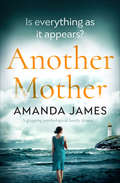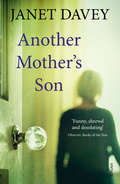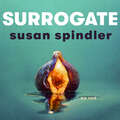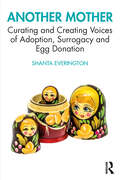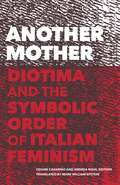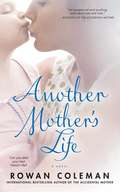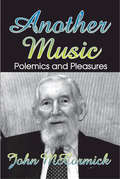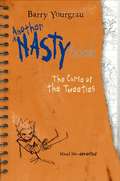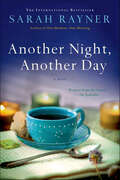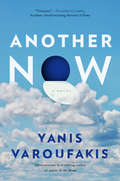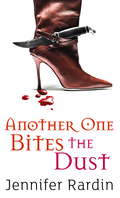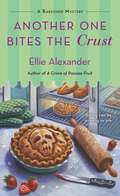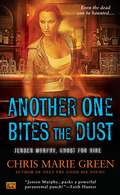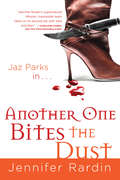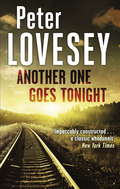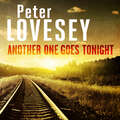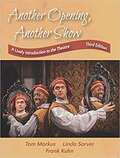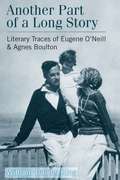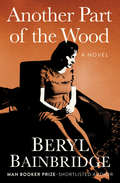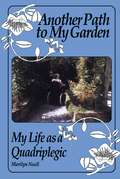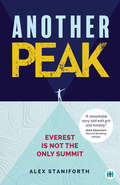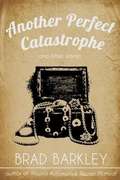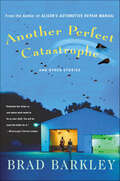- Table View
- List View
Another Mother
by Amanda JamesA woman tracks down her birth mother—but the past she&’s awakened may be more dangerous than she knows… For years, Lu has secretly dreamt of finding her birth mother. But her confidence suffers as a result of childhood bullying, and she&’s been afraid to make the leap. Then, a tragic accident changes her life forever, and sets her on a mission to get in contact and find out the reasons behind her adoption.When she tracks down her mother in Cornwall, on the English coast, there is an emotional reunion and the pair begins to form a relationship. But is everything as wonderful as it appears—or has Lu walked into a nightmare?
Another Mother's Son
by Janet Davey‘We’re lucky to have such an intelligent chronicler of our present' Tessa Hadley on Janet DaveyLorna Parry lives with her three sons, each one lurching into adulthood. Lorna struggles in the claustrophobic loneliness of her home; she’s still angry at her ex-husband, uncomfortable around her father’s new girlfriend and finds it difficult to talk to her sons. Life seems precariously balanced. Then a shocking event occurs at the boys’ school and her world threatens to implode.
Another Mother: 'An absolute belter of a page-turner' HEAT (Karen Pirie #78)
by Susan Spindler'An absolute belter of a page-turner' HEAT'A fantastic book club choice' PRIMAWould you have a baby for your daughter?Ruth has the life she always wanted - stellar career, loving family, beautiful home - but now, with an empty nest, and heading towards 55, she feels restless. Then her daughter is told that she will never be able to conceive, and Ruth discovers that, with the right dose of hormones, she could carry a child for her daughter. At first Ruth is buoyed with a new sense of purpose, but her daughter can't contain her corrosive envy, and then long-buried secrets from the past resurface. What begins a simple gift becomes something darker and more complicated - and something for which Ruth is willing to risk everything...'Gripping' COSMOPLITAN'Full of drama . . . as much about womanhood as it is about motherhood' GUARDIAN'Compulsive' KATE HAMER'Clever and compelling. I loved it' JANE SHEMILT
Another Mother: Curating and Creating Voices of Adoption, Surrogacy and Egg Donation
by Shanta EveringtonAnother Mother gives voice to women who become mothers through the routes of adoption, surrogacy and egg donation, and their silent partners – the birth mothers, surrogate mothers and egg donors – who make motherhood possible for them. Exploring experiences of motherhood beyond the biological mother raising her child, Everington draws on interviews and a range of interdisciplinary approaches to produce illuminating personal testimonies which expand our understanding of what it means to be a mother. The life writing narratives also examine the unique and hidden relationships that exist between adopters and birth mothers, egg donors and women who become mothers through egg donation, and surrogates and women who become mothers through surrogacy. Offering a fresh approach to life writing, using hybrid form encompassing edited interview, re-imagined scenes, poetry, personal essay and quotation collage, this topical book is recommended for anyone interested in motherhood studies, gender and women’s studies, life writing studies, the sociology of reproduction, creative non-fiction writing approaches, oral history and ethnography studies.
Another Mother: Diotima and the Symbolic Order of Italian Feminism (Cultural Critique Books)
by Andrea Righi Cesare CasarinoA groundbreaking volume introduces the unique feminist thought of the longstanding Italian group known as Diotima Introducing Anglophone readers to a potent strain of Italian feminism known to French, Spanish, and German audiences but as yet unavailable in English, Another Mother argues that the question of the mother is essential to comprehend the matrix of contemporary culture and society and to pursue feminist political projects. Focusing on Diotima, a community of women philosophers deeply involved in feminist politics since the 1960s, this volume provides a multifaceted panorama of its engagement with currents of thought including structuralism, psychoanalysis, linguistics, and Marxism. Starting from the simple insight that the mother is the one who gives us both life and language, these thinkers develop concepts of the mother and sexual difference in contemporary society that differ in crucial ways from both French and U.S. feminisms. Arguing that Diotima anticipates many of the themes in contemporary philosophical discourses of biopolitics—exemplified by thinkers such as Giorgio Agamben, Antonio Negri, and Roberto Esposito—Another Mother opens an important space for reflections on the past history of feminism and on feminism&’s future. Contributors: Anne Emmanuelle Berger, Paris 8 U–Vincennes Saint-Denis; Ida Dominijanni; Luisa Muraro; Diana Sartori, U of Verona; Chiara Zamboni, U of Verona.
Another Mother’s Life
by Rowan ColemanBestselling author Rowan Coleman writes a poignant story for every woman who was ever a teenager in love, a mother, or made a heartbreaking decision.
Another Music: Polemics and Pleasures
by John McCormickAs the essays in this book attest, in a time of specialization John McCormick chose diversification, a choice determined by a life spent in many occupations and many countries. After his five years in the U. S. Navy in the Second World War, the academy beckoned by way of the G. I. Bill, graduate training, and a career in teaching. Prosperity in the American university at the time meant setting up as a "Wordsworth man," a "Keats man," or a "Dr. Johnson man": all chilling to the author. He chose self-exile in which he disguised himself as an "Americanist" saleable in Europe, and lectured happily in comparative studies: literature, history, and philosophy. Thus the broad range of this volume, both in subject matter and in the span of time it covers. The essays are divided into three sections. First are general and personal essays on a variety of topics, followed by work on individual writers, and third, writings on criticism and theory. A section on Santayana reflects his eight years of research for Santayana's biography. The writings on Spain and toreo (bullfighting) result from another long-held interest, together with the author's attempt to alter some of the romantic nonsense about the running of the bulls in Pamplona, too often the entire substance of what the general public knows about Spain. McCormick has long been convinced that without knowledge of bullfighting, the foreigner cannot comprehend arcane and wonderful aspects of the Spanish character. The coda, "Another Music," is an old man's attempt to solve the mysterious algebra of how the world turns now, and how the young appear to the aged. While the volume is diverse in its range of writers--from Whitman in America to Santayana in Europe, taken as a collectivity, these essays provide a sense of the grandeur as well as the decadent in twentieth century politics and aesthetics alike. Written with the literary taste and political non-conformity that still characterizes McCormick, the volume is a treat for the specialist (perhaps) and for the generalist (certainly).
Another NASTYbook
by Barry Yourgrau Robert DejesusEver tasted a NuttiNutz candy bar? Has your Mom been kidnapped recently? Know what a Samurai Swordboy is? Are you afraid of terrible curses? Or goblins? Or Toy Poodles? How 'bout (gulp) older sisters?? Do fake false teeth ever talk to you? Hey, then you better read this book . . . but Be Warned, friend. . . . It's not like anything you've ever read . . . unless you're completely demented! (Are you?)
Another Night, Another Day: A Novel
by Sarah RaynerFrom the internationally bestselling author Sarah Rayner, Another Night, Another Day is the emotional story of a group of strangers who come together to heal, creating lifelong friendships along the way.Three people, each crying out for help.There's Karen, about to lose her father; Abby, whose son has autism and needs constant care; and Michael, a family man on the verge of bankruptcy. As each sinks under the strain, they're brought together at Moreland's Clinic. Here, behind closed doors, they reveal their deepest secrets, confront and console one another, and share plenty of laughs. But how will they cope when a new crisis strikes?
Another Now
by Yanis VaroufakisWhat would a fair and equal society actually look like? The world-renowned economist and bestselling author Yanis Varoufakis presents his radical and subversive answer in a work of speculative fiction that recalls William Morris and William Gibson The year: 2035.At a funeral for Iris, a revolutionary leftist feminist, Yango is approached by Costa, Iris&’s closest comrade, who urges him to carry out Iris&’s last wish: plough into her secret diaries to tell their story. &“But&”, Costa insists &“leave out anything that might help Big Tech replicate my technologies!&” That night Yango delves into Iris&’s diaries. In them he discovers a chronicle of how Costa&’s revolutionary technologies had unveiled an actually existing, fully democratized, postcapitalist society. Suddenly he understands Costa&’s obsession with the hackers trying to steal his secrets.So begins Yanis Varoufakis&’s extraordinary novelistic thought-experiment, where the world-famous economist offers an invigorating and deeply moving vision of an alternative reality. Another Now tells the story of Costa, a brilliant but deeply disillusioned, computer engineer, who creates a revolutionary technology that will allow the user a &“glimpse of a life beyond their dreams&” but will not enslave them. But an accident during one of its trial runs unveils a cosmic wormhole where Costa meets his DNA double, who is living in a 2025 very different than the one Costa is living in. In this parallel 2025 a global hi-tech uprising, begun in the wake of the collapse of 2008, has birthed a post-capitalist world in which work, money, land, digital networks and politics have been truly democratized. Banks have been eliminated, as well as predatory, data-mining digital monopolies; the gig economy is no more; and the young are free to experiment with different careers and to study &”non-lucrative topics, from Sumerian pottery to astrophysics.&” Intoxicated, Costa travels to England to tell Iris, his old comrade, and her neighbor, Eva, a recovering banker turned neoliberal economics professor, of the parallel universe he has discovered. Costa eventually leads them back to his workshop in America where Iris and Eva meet their own doubles, and confront hard truths about themselves and the daunting political challenge that "the Other Now" presents. But, as their obsession with the Other Now deepens, time begins to run out, as the wormhole begins to deteriorate and hackers begin to unleash new attacks on Costa&’s technology. The trio have to make a choice: which 2025 do they want to live in? Varoufakis has been claiming for a while that we already live in postcapitalist times. That, since the 2008 crisis, capitalism has been morphing into technofeudalism. Another Now, a riveting work of speculative fiction, shows that there is a realistic, democratic alternative to the technofeudalpostcapitalist dystopia taking shape all around us. It also confronts us with the greatest question: how far are we willing to go to bring it about?
Another One Bites The Dust: Book two in the Jaz Parks sequence (Jaz Parks #2)
by Jennifer RardinI'm Jaz Parks. CIA assassin. Black Belt. Belly dancer at the Corpus Christi Winter Festival. The last is cover for my latest mission: retrieve a vital piece of biotechnology by killing the maniac who stole it. The thief is not your run-of-the-mill nut job, either. He's Chien-Lung, an obsessive vamp who's invulnerable while wearing his armour - which is constantly.Then there are the reavers, ancient fiends who murder innocents and eat their souls. Only I can sense them. So it's not long before they want me dead, dead, dead. And did I mention the nightmares? They're not your garden variety sit-up-and-screamers. These suckers may actually kill me before the reavers do.
Another One Bites the Crust: A Bakeshop Mystery
by Ellie AlexanderTorte—the beloved small-town bakeshop run by Jules Capshaw—is set to hit the stage. But who would have guessed that murder would makes a surprise appearance?It’s the role of a lifetime for Jules. The Shakespeare Festival has returned to Ashland, Oregon, for the season and Torte has been cast as the supplier of Elizabethan-era treats for the main event. But on the eve of opening night, a brawl between Jules’s friend Lance, the artistic director, and a strapping young thespian named Anthony almost brings down the house. . .and the next morning, Anthony is dead. Jules knows that Lance loves his drama—and his just desserts—but she also knows that murder is way off-script for him. Now it’s up to Jules to cut through a bevy of backstage betrayals and catty co-stars who all have their own secrets—before the curtain drops on someone else. . .The Bakeshop mysteries are: “Delectable.”—Portland Book Review “Delicious.”—RT Book Reviews “Marvelous.” —Fresh Fiction
Another One Bites the Dust
by Chris Marie GreenJensen Murphy is back in the spooky sequel to Only the Good Die Young. Some people think that ghosts are spirits that refuse to go to the other side because they have unfinished business. Take my word--that's true. I should know. I'm a ghost. I was an ordinary eighties California girl, dead before my time, until psychic Amanda Lee Minter pulled me out of the time loop where I was reliving my death over and over. Now I'm Jensen Murphy, Ghost for Hire. I decided to put my spooky talents to use in helping Amanda Lee track down bad guys and killers (including my own). It's taken time to figure out exactly how that will work (our first case was definitely a learning experience for all involved), so when a young woman asks Amanda Lee for help convincing her best friend to leave a dangerously hot-tempered boyfriend, I'm ready and willing to use our collective powers on her behalf. But some people are dangerous not only to the living--especially when there are darker forces involved....
Another One Bites the Dust: Book Two In The Jaz Parks Sequence (Jaz Parks #2)
by Jennifer RardinI'm Jaz Parks. CIA assassin. Black belt. Belly dancer at the Corpus Christi Winter Festival. The last is cover for my latest mission: retrieve a vital piece of biotechnology by killing the maniac who stole it. He's Chien-Lung, an obsessive vamp who's invulnerable while wearing his armor - which is constantly.Then there are the reavers, ancient fiends who murder innocents and eat their souls. Only I can sense them. So it's not long before they'll want me dead, dead, dead.
Another One Goes Tonight
by Peter LoveseyIn the sixteenth entry of Peter Lovesey's timeless British detective series, Peter Diamond wrestles with his own moral compass, struggling to protect police prestige while debating what it means to do right by a serial killer. Two police officers are about to head home after a long night shift when they receive one last call. En route to investigate, the patrol car spins off the road, killing one of the exhausted cops and leaving the other in critical condition. Detective Peter Diamond is assigned to look into the case. His supervisor is desperately hoping Diamond will not discover the officers were at fault. Instead, Diamond discovers something even worse--a civilian on a motorized tricycle was involved in the crash and has been lying on the side of the road for hours. Diamond administers CPR, but the man's fate is unclear. Soon, though, Diamond becomes suspicious of the civilian victim and begins a private inquiry that leads to a trail of uninvestigated deaths. As the man lingers on life support, Diamond must wrestle with the fact that he may have saved the life of a serial killer.
Another One Goes Tonight (Peter Diamond Mystery #16)
by Peter LoveseyPeter Diamond, the Bath detective brilliant at rooting out murder, is peeved at being diverted to Professional Standards to enquire into a police car accident. Arriving late at the scene, he discovers an extra victim thrown onto an embankment - unconscious and unnoticed. Diamond administers CPR, but no one can say whether the elderly tricyclist will pull through.But why had the man been out in the middle of the night with an urn containing human ashes? Diamond 's suspicions grow after he identifies the accident victim as Ivor Pellegrini, a well-known local eccentric and railway enthusiast. A search of Pellegrini's workshop proves beyond question that he is involved in a series of uninvestigated deaths. While Pellegrini lingers on life support, Diamond wrestles with the appalling possibility that he has saved the life of a serial killer. . .
Another One Goes Tonight (Peter Diamond Mystery #16)
by Peter LoveseyPeter Diamond, the Bath detective brilliant at rooting out murder, is peeved at being diverted to Professional Standards to enquire into a police car accident. Arriving late at the scene, he discovers an extra victim thrown onto an embankment - unconscious and unnoticed. Diamond administers CPR, but no one can say whether the elderly tricyclist will pull through.But why had the man been out in the middle of the night with an urn containing human ashes? Diamond 's suspicions grow after he identifies the accident victim as Ivor Pellegrini, a well-known local eccentric and railway enthusiast. A search of Pellegrini's workshop proves beyond question that he is involved in a series of uninvestigated deaths. While Pellegrini lingers on life support, Diamond wrestles with the appalling possibility that he has saved the life of a serial killer. . .
Another Opening, Another Show: A Lively Introduction To The Theatre
by Tom Markus Linda Sarver Frank KuhnAnother Opening, Another Show derived from the authors asking students what they wanted in an introductory theatre textbook. They've given them exactly that: A book that doesn't cost a lot A book that is fun to read A book that helps them understand and enjoy theatre An insider's look at theatre, not a scholar's critique of it An opportunity to learn about plays on a stage rather than plays on a page Pictures that illustrate the ideas in the text instead of just decorating it Instructors will appreciate the Third Edition's modularity. Each chapter stands on its own, allowing for maximum flexibility for individual course needs. The book's inclusive approach touches on cultural diversity and gender issues in American theatre, as well as adding an entirely new chapter on Asian theatre. Photos of contemporary productions enrich the text, and a variety of side material shows students how the concepts they read about are applied by theatre professionals. Not-for-sale instructor resource material available to college and university faculty only; contact publisher directly.
Another Part of a Long Story: Literary Traces of Eugene O'Neill and Agnes Boulton
by William King"An engrossing biography about the marital breakdown of a major literary figure, of particular interest for what it reveals about O'Neill's creative process, activities, and bohemian lifestyle at the time of his early successes and some of his most interesting experimental work. In addition, King's discussion of Boulton's efforts as a writer of pulp fiction in the early part of the 20th century reveals an interesting side of popular fiction writing at that time, and gives insight into the lifestyle of the liberated woman. " ---Stephen Wilmer, Trinity College, Dublin Biographers of American playwright Eugene O'Neill have been quick to label his marriage to actress Carlotta Monterey as the defining relationship of his illustrious career. But in doing so, they overlook the woman whom Monterey replaced---Agnes Boulton, O'Neill's wife of over a decade and mother to two of his children. O'Neill and Boulton were wed in 1918---a time when she was a successful pulp novelist and he was still a little-known writer of one-act plays. During the decade of their marriage, he gained fame as a Broadway dramatist who rejected commercial compromise, while she mapped that contentious territory known as the literary marriage. His writing reflected her, and hers reflected him, as they tried to realize progressive ideas about what a marriage should be. But after O'Neill left the marriage, he and new love Carlotta Monterey worked diligently to put Boulton out of sight and mind---and most O'Neill biographers have been quick to follow suit. William Davies King has brought Agnes Boulton to light again, providing new perspectives on America's foremost dramatist, the dynamics of a literary marriage, and the story of a woman struggling to define herself in the early twentieth century. King shows how the configuration of O'Neill and Boulton's marriage helps unlock many of O'Neill's plays. Drawing on more than sixty of Boulton's published and unpublished writings, including her 1958 memoir,Part of a Long Story, and an extensive correspondence, King rescues Boulton from literary oblivion while offering the most radical revisionary reading of the work of Eugene O'Neill in a generation. William Davies King is Professor of Theater at the University of California, Santa Barbara, and author of several books, most recentlyCollections of Nothing, chosen by Amazon. com as one of the Best Books of 2008. Illustration: Eugene O'Neill, Shane O'Neill, and Agnes Boulton ca. 1923. Eugene O'Neill Collection, Beinecke Rare Book and Manuscript Library, Yale University.
Another Part of the Wood: A Novel (Soundings Ser.)
by Beryl BainbridgeSocial dysfunction meets dangerous perversion in this black comedy about two misfit families camping in the Welsh woods. George McFarley, a six-foot-eight hulk of a man obsessed with the Holocaust, and his assistant, Balfour, an unbearably shy stutterer, are the unconventional hosts of a weekend camping retreat in Wales. Their guests include Joseph, a divorced college administrator from London; Dotty, his pretty but resentful girlfriend; Roland, his young son; and Kidney, his overweight and emotionally disturbed apprentice. Also staying on for the weekend are dysfunctional couple, Lionel and May--and a Welsh groundskeeper with a creepy fondness for cattle . . . and little girls. Dotty has brought along the board game Monopoly, which she cannot live without, and which will serve as a microcosm for the roles and dramas played out by this motley crew. While the adults are caught up in petty bickering, power struggles, love triangles, and other bourgeois scandals, tragedy will befall one of the children and turn the bucolic setting into a twisted nightmare. With award-winning author Beryl Bainbridge's signature dark humor and sophisticated irony, Another Part of the Wood takes to task 1960s British cultural mores. As the plot twists and characters remove their masks, Bainbridge reveals the absurdity and danger of what is commonly considered "normal."
Another Path to My Garden: My Life as a Quadriplegic
by Marilyn NoellMarilyn Noell looks back over the past forty-three years of her life as a quadriplegic. Her struggles have been many – fear, depression, surgery, learning to use what "moving parts" remained after her diving accident when she was just nineteen. But perhaps her toughest challenge has been to be and be seen as a useful, active individual.
Another Peak: Everest is Not the Only Summit (Inspirational Series)
by Alex StaniforthReaching Everest was always the dream, but after an avalanche stopped Alex the first time and an earthquake the second, he had to take a step back. But even as he climbed down, he couldn't stop wondering 'What's next?'A restlessness in his bones, and a need to help make things better after the lives claimed in his two climbs, led Alex to his hardest mission yet: ClimbTheUK; to cycle to the highest points of the United Kingdom.But a history of anxiety, depression, and eating disorders rears its multiple heads once more, making this the hardest thing Alex has ever had to do. Finding himself alone too often, with only his thoughts for company, it becomes less of a fight of man and nature and more of man and mind.
Another Perfect Catastrophe
by Brad BarkleyWith his keen ability to evoke characters in the South and Middle America who find themselves in reduced circumstances, Brad Barkley restores our faith in human beings to endure the ravages of time with decency and humor. Out of intense loyalty, Reed feels reluctant to leave his crippled friend when his girlfriend pressures him to move on. Mourning their baby's death, a couple takes up dancing lessons to recapture their closeness. Two drifters, Bosco and Ray, scheme to murder an old man, steal his diamonds, and pay a doctor to save Bosco's life.
Another Perfect Catastrophe: And Other Stories
by Brad BarkleyIn the spirit of Tobias Wolff and Richard Ford, these ten chilling, deeply felt stories from acclaimed author Brad Barkley explore the complexity of male friendships and marital relationships. Among the stories is "The Way It's Lasted," in which Billy deals with his crumbling marriage and a visit from his father, who may or may not have cancer and who is desperate to see the reconstruction of Noah's Ark at a nearby church. "Beneath the Deep, Slow Motion" introduces us to Bosco and Ray, two drifters who scheme about murdering a neighbor and stealing his diamond collection so that they can afford to pay doctors to save Bosco from an untimely death. Nelson's mother, Myra, in "Mistletoe," has Lou Gehrig's disease, and he struggles with her request for help in killing herself before the disease does. The title story brings us to Reed, who feels reluctant to leave his childhood friend Sugar---who was crippled in a logging accident ten years ago---when Reed's much younger girlfriend, Lyndsey, pressures him to move on. In these stories and others, Barkley's prose---and his ability to create a palpable sense of time and place and mood---bring his characters vividly to life. Through these honestly crafted and carefully executed tales of people who find themselves banging their heads against their reduced circumstances, Barkley restores our faith in human beings' ability to endure the ravages of time with decency and humor. With his touching and critically praised novel Alison's Automotive Repair Manual, Barkley established himself as a writer to watch, and in Another Perfect Catastrophe, he proves to be at the height of his powers."Underline this writer as one whose work needs to be on your shelf. You will be much the better for it." ---Mississippi Clarion-Ledger
Another Person
by Kang HwagilA compulsively readable and razor-sharp campus novel about the impact of power and consent in a university settingPerfect for fans of Cho Nam-joo, I May Destroy You, and If We Were Villains by M. L. RioRiveting and uncompromising, Another Person explores the long-lasting consequences of the sexism and misogyny fostered in universities.Vacuum cleaner bitch.When Jina sees this anonymous comment on a forum it forces her out of her stupor. It is posted on a website dissecting her public allegations of workplace sexual assault, the backlash to which forced her to quit her job. She has spent months glued to her laptop screen, junk-food packaging piling up around her, tracking the hate campaign that's raging against her online. This post stands out from the noise, for it could only have been made by someone who knew her as a student at university.The comment stirs something deeply repressed. So Jina returns to Anjin University, and to the toxic culture that destroyed the lives of many female students including one, Ha Yuri, who died tragically and mysteriously not long before Jina left. Somewhere within Jina's memories is the truth about what happened to Yuri all those years ago.Told in alternating viewpoints, in sharp, intelligent and multi-layered prose, this powerful and necessary novel confronts issues of sexism and abuse on university campuses.
